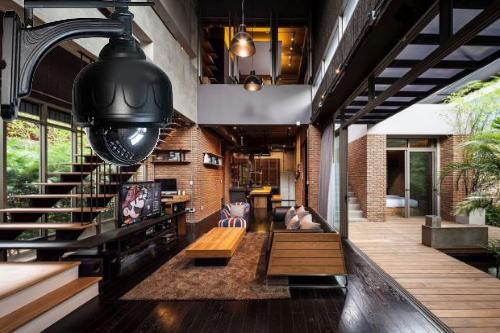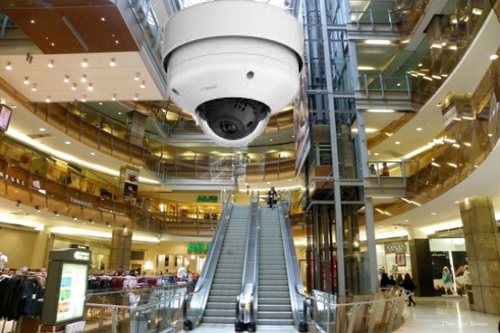5 Types of IP Cameras

Fixed network cameras
>>A fixed network camera is a camera that has a fixed viewing direction once it is mounted.
>>It may come with a fixed, varifocal or motorized zoom lens, and the lens may be exchangeable on some cameras.
>>A fixed camera is the traditional camera type where the camera and the direction in which it is pointing are clearly visible.
>>This type of camera represents the best choice in applications where it is advantageous to make the camera very noticeable.
>>Fixed cameras can be installed in protective enclosures. Outdoor fixed cameras come pre-installed in housings.
>>Fixed cameras can also be mounted on a pan/tilt motor for greater viewing flexibility.

Fixed dome network cameras
>>A fixed dome network camera is a fixed camera in a dome design. It may come with a fixed, varifocal or motorized zoom lens, and the lens may be exchangeable on some cameras.
>>The camera can be directed to point in any direction. Its main benefit lies in its discreet, non-obtrusive design, as well as in the fact that it is hard to see in which direction the camera is pointing.
>>Fixed dome cameras provide different types and levels of protection such as vandal- and dust-resistance, and IP66 and NEMA 4X ratings for outdoor installations.
>>The cameras can be mounted on a wall, ceiling or pole.A fixed dome with a wide-angle lens and a megapixel sensor that provides a 360° field of view is often known as a panoramic or 360° camera

Covert network cameras
>> Covert cameras are designed to blend into the environment and be virtually impossible to discover.
>> They can be placed at eye-level at entrances or integrated into things such as ATM machines for discreet or covert surveillance.
>>They can enable close-up shots for identification purposes or overview surveillance. Tampering risks are also reduced.
>>Using a pin-hole lens, Axis’ indoor/outdoor covert network cameras provide resolutions of up to 1 MP, including HDTV 720p, and come pre-mounted with an Ethernet cable for both power and data.
>>The cameras are ideal for use in retail stores, banks and hospitals
PTZ network cameras
A PTZ camera provides pan, tilt and zoom functions (using manual or automatic control), enabling wide area coverage and great details when zooming in.
An PTZ camera usually has the ability to pan 360°, tilt 180° or 220°, and is often equipped with a zoom lens. (A zoom lens provides an optical zoom that maintains image resolution, as opposed to a digital zoom, which enlarges an image with loss in image quality.)
PTZ commands are sent over the same network cable as for video transmission . PTZ cameras with support for Power over Ethernet (PoE/PoE+/High PoE) also do not require separate power cables, unlike an analog PTZ camera.
PTZ cameras can come in various form factors; the most common is a PTZ dome, which is ideal for use in discreet installations due to its design, mounting (particularly in indoor, dropceiling mounts), and difficulty in seeing the camera’s viewing angle. In outdoor installations, the cameras are usually mounted on poles or walls of a building.
In operations with live monitoring, PTZ cameras can be used to follow a person or object, and zoom in for closer inspection. In unmanned operations, automatic guard tour on PTZ cameras can be used to monitor different areas of a scene.
In guard tour mode, one PTZ network camera can cover an area where many fixed network cameras would be needed. The main drawback is that only one location can be monitored at any given time.
PTZ domes offer high-speed endless pan, tilt and zoom, and provide mechanical robustness for continuous operation in guard tour mode. PTZ domes with a mechanical stop incorporate Auto-flip functionality to enable them to pan 360°.
Thermal network cameras
Thermal network cameras create images based on heat that radiates from all objects. Images are generally produced in black and white but can be artificially colored to make it easier to distinguish different shades.
Thermal images are best when there are great temperature differences in a scene; the hotter an object, the brighter it is in a thermal image.
Thermal cameras are ideal for detecting people, objects and incidents in shadows, complete darkness or in other challenging conditions such as smoke and dust. The cameras are used primarily to detect suspicious activities as thermal images do not enable reliable identification. They, therefore, complement and support conventional network cameras in a surveillance installation.
Thermal cameras can be used for perimeter or area protection, providing a powerful and cost-effective alternative to radio frequency intruder detection, electrified fences and flood lights. In the dark, they provide discreet surveillance since there is no need for artificial light. In public areas, thermal cameras can help secure dangerous or off-limit areas such as tunnels, railway tracks and bridges.
Indoor uses include building security and emergency management, enabling humans to be detected inside a building, whether after business hours or during emergencies such as a fire. Thermal cameras are often used in high security buildings and areas such as nuclear power plants, prisons, airports, pipelines and sensitive railway sections.
A thermal camera requires special optics since regular glass will block the thermal radiation. Most thermal camera lenses are made using germanium, which enables infrared light and thermal radiation to pass through. How much or how far away a thermal camera can “see” or detect depends on the lens.
A wide-angle lens enables a thermal camera to have a wider field of view, but a shorter detection range than a telephoto lens, which provides a longer detection range with a narrower field of view.
A thermal camera’s sensitivity to infrared radiation is expressed as its NETD value (Noise Equivalent Temperature Difference). The lower the NETD value, the better the sensitivity to infrared radiation.